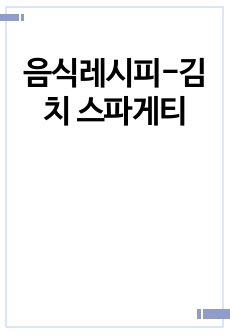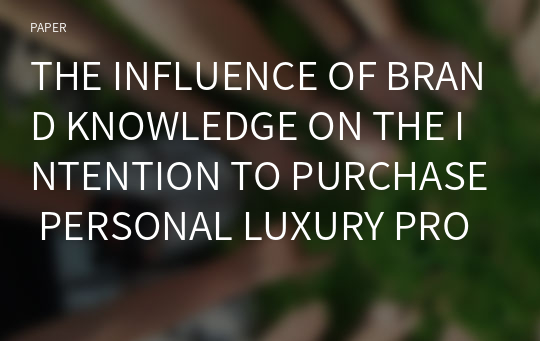THE INFLUENCE OF BRAND KNOWLEDGE ON THE INTENTION TO PURCHASE PERSONAL LUXURY PRODUCTS
* 본 문서는 배포용으로 복사 및 편집이 불가합니다.
서지정보
ㆍ발행기관 : 글로벌지식마케팅경영학회(GFMC)
ㆍ수록지정보 : GFMC Session1
ㆍ저자명 : Kanyanee Ingsa, Li-Wei Mai
ㆍ저자명 : Kanyanee Ingsa, Li-Wei Mai
영어 초록
This conceptual paper discusses the influence of brand knowledge through various components of personal luxury products’ towards the purchase intention. Rapid shifts in luxury consumers’ behaviours is one of the predominant drivers contributing to the growth of the modern luxury market. In response to this, luxury consumers’ characteristics and profiles need to be reexamined.In recent years, there has been a rapid increase in global luxury consumption with the rise in number of luxury consumers from 140 million to 350 million globally (Bain & Company, 2015). Such a phenomenal growth in the luxury market leads to a widely increased interests among researchers across all disciplines (Truong et al., 2008; 2009, Tynan et al., 2010; Kapferer & Valette-Florence, 2016). In particular, personal luxury goods market is forecast to continue to grow between 2-3 percent through 2020 (Bain & Company, 2016). Despite the fact that personal luxury goods is a major driver of the entire market, there is a limited research in this product category.
Two factors of this fast-growing trend stimulate the need for additional research into consumers’ behaviours. First, there has been a shift in luxury consumers’ profile (Hanna, 2004; Fionda & Moore, 2009) and purchasing patterns (Bain & Company, 2015; 2016) where social influences (Dubois et al., 2001; Berthon et al., 2009; Cheah et al., 2015; Yang and Mattila, 2014; Kapferer & Valette-Florence, 2016) and people’s needs for materialism, appearances to enhance their ego and self-concept (Phau & Prendergast, 2000; Kapferer, 2006) are having greater impact on how consumers make their luxury purchase decisions. Second, it appears that the characteristics of the traditional luxury consumers as well as old marketing models from many decades ago need to be redefined (Bain & Company, 2015). Danziger (2005) indicates that the changes in luxury consumers’ purchase decision has created a dramatic shift in the purchase behaviour as a whole, making it difficult for luxury marketers to recognise the trend.
To date, existing literature on luxury purchase intention focuses mainly from the cultural, economic, psychological perspectives (Leibenstein, 1950; Veblen, 1899; Bian & Forsythe, 2012; Liu et al., 2012; Wong & Ahuvia, 1998; Vigneron & Johnson, 2004; Shukla, 2012; Cheah et al., 2015) but remains limited on investigating luxury consumers’ behaviours through the integration of brand knowledge domain. Major works from marketing scholars on luxury value perceptions (Wiedmann et al., 2007 and 2009; Vigneron & Johnson, 2004; Shukla, 2012; Shukla & Purani, 2013; De Barnier et al., 2006; Hennigs et al., 2012 and 2013) suggest that they are important in explaining the whole picture of luxury consumption but insufficient in explaining purchase intentions (Shukla, 2012).
Kapferer (2006) discusses that it is typical for consumers to identify which brand belongs to the luxury category, however, it could be more complex for the precise definition of luxury to be identified and understood. Therefore, this study seeks to incorporate the branding aspects into the investigation on the significance of brand knowledge towards the intention to purchase personal luxury products.
Literature Review
The concept of luxury is first explained by Veblen (1899) that the consumption of luxury goods is primarily considered by the affluent consumers with the desire to display their wealth to the relevant significant others. Even though the concept of luxury remains obscure, the clearer definition of luxury is given by Nueno & Quelch (1998) as the “ratio of functional utility to price is low while the ratio of intangible and situational utility to price is high” and that luxury products are beyond an ordinary expensive goods but “an ephemeral status symbol”. Shukla (2010) also defines luxury as the consumption that is not for just oneself but a socially-oriented type of consumption that fulfils the consumers’ own indulgence as well as to serve the “socially directed motives”.
The aforementioned definitions of luxury show it is an “elusive concept” (Kapferer, 1998) with “fuzzy frontiers” (Kapferer, 2006). The luxury concept is describes as “incredibly fluid, and changes dramatically” over time and varied among different cultures (Yeoman and McMahon-Beattie 2006). As consumers become richer (Fionda & Moore, 2009) and are able to afford more luxury brands (Nueno & Quelch, 1998), luxury is no longer reserved for the rich but also includes the rising number of aspiring middle-class consumers (Shukla, 2012) who enjoy material comfort (Yeoman & McMahon-Beattie, 2006; Yeoman, 2011: Granot et al., 2013). This change makes the term luxury even more difficult to define (Shukla, 2010) and will continue as an ongoing debate among research scholars (Kapferer & Valette-Florence, 2016).
Dubois & Paternault (1995) mention that “luxury items are bought for what they mean, beyond what they are”, this statement defines the nature of luxury brands where consumers often purchase luxury products not merely because of their outstanding quality but because of the name and the symbolic identity the brand provides. Kapferer (1998) recognises the importance in exploring the perception of luxury brands from the end-users themselves because they know best. This also adds to the ongoing complexity and difficulties in giving luxury a discreet definition (Kapferer, 1997 and 1998). The work of Grotts & Johnson (2013) investigates the status consumption of millennial consumers and indicates that it is highly possible that the consumers may not express any interest on the quality of the products but are placing greater emphasis on the ability of the handbags to be recognised and generate attention from their reference groups.
With regard to marketing strategy, luxury marketers react to the rapid increase in demand to maintain their position of exclusivity by increasing the price every year in order to secure their clientele (Kapferer, 2015b). Louis Vuitton, Rolex, and Christian Dior increase the price of their products every year to sustain the dream value of the consumers (Kapferer, 2015a; 2015b). It is apparent that most luxury companies are managing the dilemma of maintaining the exclusivity of its products while increasing brand awareness as well as focusing on securing more market share and revenue (Kastanakis & Balabanis, 2012; Berthon et al., 2009). Despite the recognisable shifts in luxury consumption pattern, the sector will continue to grow with the majority of affluent consumers as discussed by Steve Kraus of Ipsos (King, 2015).
The most recognisable shift in luxury marketing strategy is on the increasing number of luxury companies offering lower-price products in response to the rising level of demand for luxury consumption by the enthusiastic middle class consumers (Truong et al., 2008; Kastanakis & Balabanis, 2012). Luxury was once reserved for the “happy few” (Veblen, 1899) but this notion is no longer practical for today’s luxury environment where luxury products are “consumed by a larger aspirational segment” (Granot et al., 2013).
Democratisation of luxury refers to when luxury brands create a lower-priced accessory items in order to appeal to the broader market, making luxury accessible to those “who could never afford to purchase the principal items in the line” (Nueno & Quelch, 1998) or the new luxury consumers who seeks recognition from luxury purchase. Han et al. (2010) discusses that different classes of consumers can now be distinguished by the brands of purses, watches, or shoes that they own. They let the brands speak for them, whether they prefer the loud Gucci logo or displaying the consumption of a “‘no logo’ strategy” by carrying a Bottega Veneta bag (Han et al., 2010).
As Husic & Cicic (2009) state, an important question on today’s luxury consumption that if it is possible for everyone to obtain luxury items, are the brands still considered luxury? This is one of the important agendas concerning luxury consumption that prompts researchers to investigate this changing behaviours and perceptions of luxury consumers. It is also significance to note that the increase in global demand in luxury market is not necessarily positive but could be negative if the demand is not being managed efficiently (Hennigs et al., 2015). Despite frequent changes in luxury consumption patterns, Kapferer & Valette-Florence (2016) argues that it is vital to understand how consumers behave in order for the brands to create and maintain trust and reputation among its consumers.
Danziger (2005) argues that the notion of “past behaviour predicts future behavior” may not be applicable to the luxury market. However, the foundation remains where the marketers need to understand the basics about the past and present behaviours in order to offer the products and services at the price that luxury consumers are willing to pay. It is partly due to the minimisation of the possible risks that might occur in purchasing luxury products as stated by Kapferer & Valette-Florence (2016) that “in luxury, no one wants to buy the wrong brand”.
In light of these changes in the demand and strategies, a new framework of luxury purchase intention will be presented. This framework integrates brand knowledge in order to accommodate the traditional consumer, who appreciates the brand and its exclusivity, as well as the new buyer who wants recognition. This attempt in merging the two groups of luxury consumers together will highlights how traditional and new luxury consumers make their purchase decisions based on different components of luxury product characteristics as well as different value perception, or that is to say, based on a different levels of brand knowledge.
Conceptual Framework
Over several decades scholars attempted to agree on a single comprehensive definition for the term ‘luxury’ but have not yet reached that goal because the concept of luxury is highly individual and the market itself is heterogeneous (Hennigs et al., 2013). The definition of luxury, therefore, is very complex to define (Vigneron & Johnson, 1999; Dubois & Duquesne, 1993) due to its “subjective character” (De Barnier et al., 2012) with many diverse facets (Phau & Prendergast, 2000).
This study provides a new perspective by looking at the factors that influence luxury purchase intention. Based on the original work of Keller (1993), it is important to understand the structure and content of brand knowledge because these dictate what comes into the consumer’s mind when they think about a brand and what they know about the brand (Keller, 2003). Consumer brand knowledge is defined as the “personal meaning about a brand stored in consumer memory, that is, all descriptive and evaluative brand-related information” (Keller, 2003). Strong, unique, and favorable brand associations must be created with consumers (Kotler & Keller, 2012 and 2016).
In luxury consumption, different consumers seek different emotional and functional benefits from luxury brands (Kapferer, 1998), which makes it relevant and significant to investigate the level of influences of brand knowledge and value perceptions on the intention to purchase luxury products.
The proposed conceptual framework for this study is presented in Figure 1 in the Appendix section.
Managerial Implications
This study provides both theoretical and managerial implications. On theoretical grounds, this study provides an enhanced model in investigating the influence of luxury brand knowledge towards luxury purchase intention considering luxury brand characteristics and luxury value perceptions.
On managerial perspective, this study provides an update in the modern luxury consumers consumption pattern in terms of what specific characteristics of luxury products they would consider when they intend to purchase. At the same time, this study analyses the types of luxury value perceptions acknowledge by modern luxury consumers towards their purchase decision. In addition, the proposed conceptual framework will take into account the behaviours of traditional luxury consumers, who seems to have been lost due to the increased demand among the new luxury consumers. According to Keller et al. (2012), the marketers of the brand needs to acknowledge the insights to how brand knowledge exists in consumer memory. From the model, marketers can plan and execute efficient marketing and communication strategies for modern luxury consumers given their fast-changing preference in luxury consumption. Following the suggestion from Kapferer & Valette-Florence (2016) which indicates that “luxury is made by brands” and apart from selling luxurious products, the dream is what is attached to the brand logo and name. Therefore, by investigating the relationship between luxury products characteristics along with luxury value perceptions, this study aims to provide a refreshing analysis of today’s luxury consumers and what stimulates them to buy personal luxury products.
Further Research
A questionnaire will be developed by the integration of the established measurements and scales from the existing luxury consumption and branding literature. A draft of the questionnaire will be reviewed against the literature and the practical insights obtained from the sales associates and experts in the luxury industry for the suitability and clarity of the questions. The final draft of the questionnaire will be pre-test on a small number of respondents from the target audience. The target population for the study is among general luxury consumers. The data collected from the survey will be analysed using Structural Equation Modelling (SEM) approach to model decision process and validate the proposed conceptual framework. Cluster analysis will be used to identify segments of consumers as recommended by Aaker et al. (2013). The anticipated research findings will expand on the degree of influences of the brand knowledge towards the willingness to purchase of personal luxury goods. It is also expected that the research findings will be useful in redefining the existing types of luxury consumers to represent today’s luxury consumers.
참고 자료
없음"GFMC Session1"의 다른 논문
 FAST AND SLOW FASHION BRANDS IN DEVELOPING SUSTAINABLE ..6페이지
FAST AND SLOW FASHION BRANDS IN DEVELOPING SUSTAINABLE ..6페이지 “WHAT IF A CELEBRITY AND A BRAND CO-CREATE A NEW COLLEC..7페이지
“WHAT IF A CELEBRITY AND A BRAND CO-CREATE A NEW COLLEC..7페이지 THE INSTAGRAM’S STRATEGY IN ENGAGING THE CUSTOMER’S LOY..3페이지
THE INSTAGRAM’S STRATEGY IN ENGAGING THE CUSTOMER’S LOY..3페이지 THE PARTICULARITIES OF NEW PRODUCT DEVELOPMENT IN THE T..5페이지
THE PARTICULARITIES OF NEW PRODUCT DEVELOPMENT IN THE T..5페이지 THE LONE CHOCOLATE BAR: THE INFLUENCE OF PERCEIVED SCAR..6페이지
THE LONE CHOCOLATE BAR: THE INFLUENCE OF PERCEIVED SCAR..6페이지 ADS AS WORKS OF ART: MEASURING ADVERTISING IMMERSION3페이지
ADS AS WORKS OF ART: MEASURING ADVERTISING IMMERSION3페이지 ECONOMIES OF SMALL: NICHE STRATEGIES AND SUCCESS FACTOR..8페이지
ECONOMIES OF SMALL: NICHE STRATEGIES AND SUCCESS FACTOR..8페이지 THE INFLUENCE OF ONLINE CUSTOMER REVIEWS ON RETAILERS' ..6페이지
THE INFLUENCE OF ONLINE CUSTOMER REVIEWS ON RETAILERS' ..6페이지 IS THE ARTIFICATION PROCESS PERCEIVED BY FINAL CONSUMER..6페이지
IS THE ARTIFICATION PROCESS PERCEIVED BY FINAL CONSUMER..6페이지 THE ODD EVEN PRICE PARADOX IN THE FASHION LUXURY SECTOR6페이지
THE ODD EVEN PRICE PARADOX IN THE FASHION LUXURY SECTOR6페이지


























